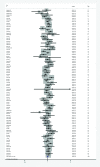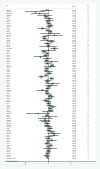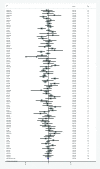miR-146a C/G polymorphism increased the risk of head and neck cancer, but overall cancer risk: an analysis of 89 studies
- PMID: 29208766
- PMCID: PMC6435476
- DOI: 10.1042/BSR20171342
miR-146a C/G polymorphism increased the risk of head and neck cancer, but overall cancer risk: an analysis of 89 studies
Abstract
Several studies have evaluated the association of miR-146a C/G with head and neck cancer (HNC) susceptibility, and overall cancer risk, but with inconclusive outcomes. To drive a more precise estimation, we carried out this meta-analysis. The literature was searched from MEDLINE (mainly PubMed), Embase, the Cochrane Library, and Google Scholar databases to identify eligible studies. A total of 89 studies were included. The results showed that miR-146a C/G was significantly associated with increased HNC risk in dominant model (I2 =15.6%, Pheterogeneity=0.282, odds ratio (OR) =1.088, 95% confidence interval (CI) =1.002-1.182, P=0.044). However, no cancer risk was detected under all genetic models. By further stratified analysis, we found that rs4919510 mutation contributed to the risk of HNC amongst Asians under homozygote model (I2 =0, Pheterogeneity=0.541, OR =1.189, 95% CI =1.025-1.378, P=0.022), and dominant model (I2 =0, Pheterogeneity=0.959, OR =1.155, 95% CI =1.016-1.312, P=0.028). Simultaneously, in the stratified analysis by source of controls, a significantly increased cancer risk amongst population-based studies was found under homozygote model, dominant model, recessive model, and allele comparison model. However, no significant association was found in the stratified analysis by ethnicity and source of control. The results indicated that miR-146a C/G polymorphism may contribute to the increased HNC susceptibility and could be a promising target to forecast cancer risk for clinical practice. However, no significant association was found in subgroup analysis by ethnicity and source of control. To further confirm these results, well-designed large-scale case-control studies are needed in the future.
Keywords: cancer risk; head and neck cancer; meta-analysis; miR-146a C/G; polymorphism.
© 2018 The Author(s).
Conflict of interest statement
The authors declare that there are no competing interests associated with the manuscript.
Figures











Similar articles
-
MiR-146a rs2910164 polymorphism and head and neck carcinoma risk: a meta-analysis based on 10 case-control studies.Oncotarget. 2017 Jan 3;8(1):1226-1233. doi: 10.18632/oncotarget.13599. Oncotarget. 2017. PMID: 27901485 Free PMC article.
-
MiR-146a rs2910164 polymorphism increases risk of gastric cancer: a meta-analysis.World J Gastroenterol. 2014 Nov 7;20(41):15440-7. doi: 10.3748/wjg.v20.i41.15440. World J Gastroenterol. 2014. PMID: 25386093 Free PMC article. Review.
-
[Association between miR-146a single nucleotide polymorphism and genetic susceptibility to hepatocellular carcinoma: a meta-analysis].Zhonghua Gan Zang Bing Za Zhi. 2017 Oct 20;25(10):749-754. doi: 10.3760/cma.j.issn.1007-3418.2017.10.006. Zhonghua Gan Zang Bing Za Zhi. 2017. PMID: 29108203 Chinese.
-
The association between miR-146a gene rs2910164 polymorphism and gastric cancer risk: a meta-analysis.Biomed Pharmacother. 2014 Oct;68(8):923-8. doi: 10.1016/j.biopha.2014.10.002. Epub 2014 Oct 14. Biomed Pharmacother. 2014. PMID: 25455160
-
Effect of a common genetic variant microRNA-146a rs2910164 on colorectal cancer: a meta-analysis.J Dig Dis. 2014 Dec;15(12):647-53. doi: 10.1111/1751-2980.12201. J Dig Dis. 2014. PMID: 25283877 Review.
Cited by
-
The Role of Single Nucleotide Polymorphisms in MicroRNA Genes in Head and Neck Squamous Cell Carcinomas: Susceptibility and Prognosis.Genes (Basel). 2024 Sep 20;15(9):1226. doi: 10.3390/genes15091226. Genes (Basel). 2024. PMID: 39336817 Free PMC article. Review.
References
Publication types
MeSH terms
Substances
LinkOut - more resources
Full Text Sources
Other Literature Sources
Medical
Molecular Biology Databases

